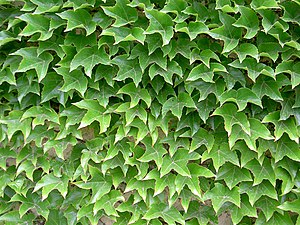Three-pronged virgin vine
| Three-pronged virgin vine | ||||||||||||
|---|---|---|---|---|---|---|---|---|---|---|---|---|

Three-pronged virgin vine ( Parthenocissus tricuspidata ) |
||||||||||||
| Systematics | ||||||||||||
|
||||||||||||
| Scientific name | ||||||||||||
| Parthenocissus tricuspidata | ||||||||||||
| ( Sieb. & Zucc. ) Planch. |
The Parthenocissus tricuspidata ( Parthenocissus tricuspidata ), often Trifoliate or trilobal Woodbine and how other similar types Wild wine called, is a plant from the family grapevine family (Vitaceae). Some types are used for facade greening. Rare common names are also Dreilappige Zaunrebe, Veitschrebe, Veitschii or wall cat. The type epipheton tricuspidata means "three-pointed" and is derived from the Latin tri "three" and cuspidatus "pointed".
features
The three-pointed virgin vine is a deciduous climbing shrub and can reach a height of over 20 meters on vertical walls. The individual tendrils are about two to three centimeters long and have six to ten adhesive discs that attach the plant to the base.
The leaves are usually three-lobed and only rarely undivided. The individual lobes are tapered and roughly serrated. The long-stalked leaves are 10 to 20 centimeters long. The upper side of the leaf blade is shiny and bare, the underside is dull green and only has sparse hair on the veins . The leaf color is reddish green to bronze when it shoots, then orange yellow to intense scarlet red in autumn.
In the flowering period from July to August, many flowers are in umbrella panicles terminal or axillary on short shoots with few leaves . The greenish tinted flowers are small and inconspicuous.
The blue-black berry fruits ripen from October and have a diameter of up to 8 millimeters. The fruits are inedible for humans.
The number of chromosomes is 2n = 40.
Location and distribution
The three-pronged virgin vine is native to Japan , China and Korea and thrives there in floodplain bushes, woody trees that accompany rivers and damp mixed mountain forests.
Some varieties are used for wall greening and also thrive very well in large cities. This species rarely grows wild, although the abundant fruits are eaten by songbirds.
history
This species was brought to the Netherlands before 1867 and was described as Ampelopsis tricuspidata by Philipp Franz von Siebold and Joseph Gerhard Zuccarini .
Even John Gould Veitch , who in 1860 visited Japan, plants and seeds sent to England. There the specimens were regarded as a separate species, Ampelopsis veitchii , but are now only considered a variety of the diverse P. tricuspidata . As early as 1868, this plant was marketed as a best seller by the horticultural company Veitch and Sons in Exeter .
literature
- Manfred A. Fischer , Wolfgang Adler, Karl Oswald: Excursion flora for Austria, Liechtenstein and South Tyrol. 2nd, improved and enlarged edition. State of Upper Austria, Biology Center of the Upper Austrian State Museums, Linz 2005, ISBN 3-85474-140-5 .
- Kremer: shrub trees . Niedernhausen 2002, ISBN 3-576-11478-5
- Heinz-Dieter Krausch : Imperial crown and peonies red ... - Discovery and introduction of our garden flowers. Dölling and Galitz, Hamburg 2003, ISBN 3-935549-23-7
- Helmut Genaust: Etymological dictionary of botanical plant names. 3rd, completely revised and expanded edition. Birkhäuser, Basel / Boston / Berlin 1996, ISBN 3-7643-2390-6 (reprint ISBN 3-937872-16-7 ).
Pictures in the turn of the year
Individual evidence
- ^ Erich Oberdorfer : Plant-sociological excursion flora for Germany and neighboring areas . 8th edition. Verlag Eugen Ulmer, Stuttgart 2001, ISBN 3-8001-3131-5 . Page 654.





